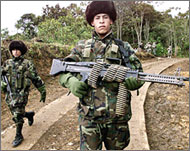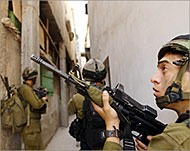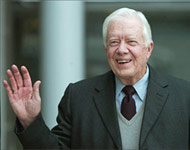Israel’s Latin American trail of terror
The following article published by Al Jazeera in 2003 reveals important facts about the history of the Israel in Latin America.
“I learned an infinite amount of things in Israel, and to that country I owe part of my essence, my human and military achievements” said Colombian paramilitary leader and indicted drug trafficker Carlos Castao in his ghostwritten autobiography, Mi Confesin.
 Israelis did dirty work for the U.S.
Israelis did dirty work for the U.S.
Castao, who leads the Colombian paramilitaries, known by their Spanish acronym AUC, the largest right-wing paramilitary force to ever exist in the western hemisphere reveals that he was trained in the arts of war in Israel as a young man of 18 in the 1980s.
He glowingly adds: “I copied the concept of paramilitary forces from the Israelis,” in his chapter-long account of his Israel experiences.
Castao’s right-wing Phalange-like AUC force is now by far the worst human rights violator in all of the Americas, and ties between that organisation and Israel are continually surfacing in the press.
Outside the law
The AUC paramilitaries are a fighting force that originally grew out of killers hired to protect drug-running operations and large landowners. They were organised into a cohesive force by Castao in 1997. It exists outside the law but often coordinates its actions with the Colombian military, in a way similar to the relationship of the Lebanese Phalange to the Israeli army throughout the 1980s and 1990s.
According to a 1989 Colombian Secret Police intelligence report, apart from training Carlos Castao in 1983, Israeli trainers arrived in Colombia in 1987 to train him and other paramilitaries who would later make up the AUC.
 |
| Colombian paramilitaries were trained by Tel Aviv |
The Colombian AUC paramilitaries are always in need of arms, and it should come as no surprise that some of their major suppliers are Israeli. Israeli arms dealers have long had a presence in next-door Panama and especially in Guatemala.
In May of last year, GIRSA, an Israeli company associated with the Israeli Defence Forces and based in Guatemala was able to buy 3000 Kalashnikov assault rifles and 2.5 million rounds of ammunition that were then handed over to AUC paramilitaries in Colombia.
Israel’s military relations with right-wing groups and regimes spans Latin America from Mexico to the southernmost tip of Chile, starting just a few years after the Israeli state came into existence.
Since then, the list of countries Israel has supplied, trained and advised includes Argentina, Bolivia, Brazil, Colombia, Costa Rica, Dominican Republic, Ecuador, El Salvador, Guatemala, Haiti, Honduras, Nicaragua, Panama, Paraguay, Peru and Venezuela.
But it isn’t only the sales of planes, guns and weapons system deals that characterises the Israeli presence in Latin America.
 |
| Israeli forces’ involvement in El Salvador runs deep |
From 1975 to 1979, 83% of El Salvador’s military imports came from Israel, according to the Stockholm International Peace Research Institute. By 1981, many of those in the civilian popular political movements who had survived the death squads headed for the hills to become guerrillas.
By 1981 there was an open civil war in El Salvador which took over a decade to resolve through negotiations.
Even though the US was openly backing the Salvadoran Army by 1981, as late as November 1983 it was asking for more Israeli “practical assistance” there, according to a declassified secret document obtained recently by Aljazeera.
Among the assistance asked for were helicopters, trucks, rifles, ammunition, and combat infantry advisors to work at both the “company and battalion level of the Salvadoran Army”.
One notable Salvadoran officer trained by the Israelis was Major Roberto D’Aubuisson, who always held a high opinion of the Israelis. It was Major D’Aubuisson who ordered the assassination of El Salvador’s archbishop amongst thousands of other murders.
Dirty war
Amazingly, while the Israelis were training the El Salvadoran death squads they were also supporting the anti-semitic Argentine military government of the late 1970s and early 1980s – at a time when that government was involved in another “dirty war” of death squads and disappearances.
In 1978, Nicaragua’s dictator Somoza was making his last stand against a general uprising of the Sandinista-led population who were sick of his family’s dynasty which had ruled and monopolised the county for half a century. The Israelis and the US had been supplying Somoza with weapons for years. But when President Jimmy Carter came into office in 1976 he ordered a cessation of all US military assistance to Nicaragua.
 |
| Israel utilised Carter’s human rights policy to its advantage |
Filling the void, the Israelis immediately increased their weapons supplies to Somoza until he fled the country when the Sandinistas took power.
At least some of the same Israeli operatives had also previously trained the nucleus of the paramilitary organisations that would become the AUC in Colombia.
But by far the bloodiest case of Israeli involvement in Latin America was its involvement in Guatemala from the 1970s to the 1990s. As in El Salvador, a civil war pitted a populist but, in this case, mainly Indian left against a mainly European oligarchy protected by a brutal Mestizo Army.
As Guatemalan President Carlos Arana said in 1971, “If it is necessary to turn the country into a cemetery in order to pacify it, I will not hesitate to do so.”
Active involvement
Like Israel’s original occupation of Palestine, several entire Guatemalan Indian villages were razed and a million people displaced. “The guerrilla is the fish. The people are the sea. If you cannot catch the fish, you have to drain the sea,” said Guatemalan President Rios Montt in 1982.
Guatemalan army officers credit Israeli support with turning the tide against the uprising, not only in the countryside where Israeli counter-insurgency techniques and assistance set up strategic-hamlet-like “development poles” along the lines of the Israeli kibbutz, but also in the cities where “Israeli communication technicians and instructors” working through then-sophisticated computers were able to locate and then decimate guerrillas and their supporters in Guatemala City in 1981.
From the late 1970s until the 1990s, the US could not overtly support the Guatemalan army because of its horrendous human rights record (although there was some covert support), but many in the US government, especially in the CIA, supported Israel in taking up the slack.
Wrong
 |
| Israelis were convenient for the US as cover-ups |
Besides the dozen or so Kfir IAI C-7 jet fighters they have sold the Colombian government, and the Galil rifles produced in Bogota under licence, most of the Israeli ties to the government’s counter-insurgency war are closely-guarded secrets.
Aljazeera’s attempts to obtain clarification on these and other issues for this story were stonewalled by the Israeli embassy in Washington.
Why does Israel continue to provide arms and expertise to the pariahs of the world? Clearly, part of the reason is the revenues produced by arms sales, and part of it has do with keeping up with trends in counter-insurgent war across the globe.
But another factor is what is demanded of Israel by the world’s only superpower, the US, in partial exchange for the superpower’s continued support for Israeli dominance in the Middle East.
Assistance
Another document, this time a 1983 cable from the US Ambassador in Guatemala to Washington Frederic Chapin shows the money trail. He says that at a time when the US did not want to be seen directly assisting Guatemala, “we have reason to believe that our good friends the Israelis are prepared, or already have, offered substantial amounts of military equipment to the GOG (Government of Guatemala) on credit terms up to 20 years…(I pass over the importance of making huge concessionary loans to Israel so that it can make term loans in our own backyard).”
In other words, during civil wars in which the US does not want to be seen getting its hands dirty in Latin America, the superpower loans Israel money at a very good rate, and then Israel uses these funds to do the “dirty work”. In this regard, in Latin America at least, Israel has become the hit-man for the US.
